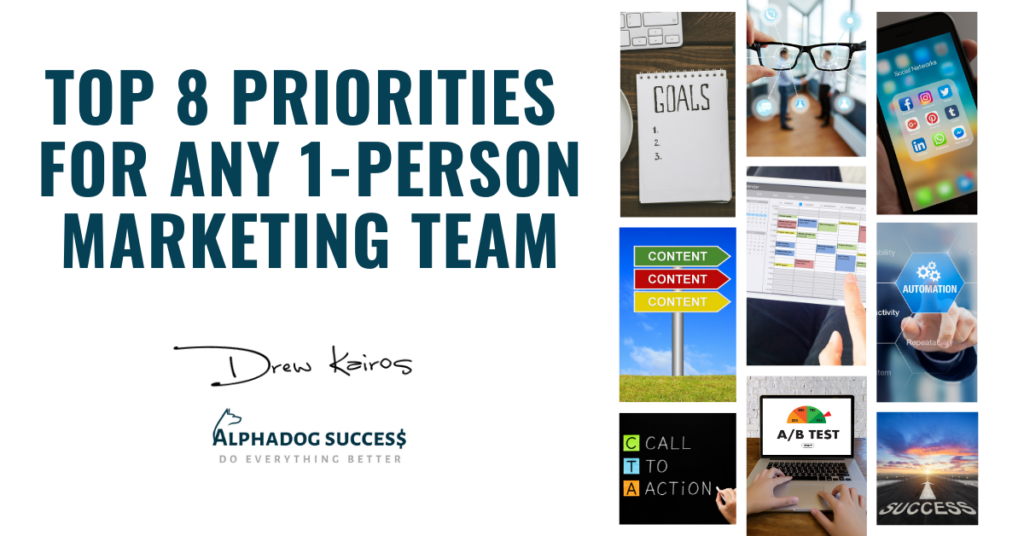You could easily succeed if you had a dedicated team, a million-dollar marketing budget, and 48 hours in a day. But that’s not how real life works. Especially for a new entrepreneur or one-person marketing team.
It’s easy to get into the “if only” mindset when you’re the only employee/marketer at your company. But if you want to grow your business, it’s important to get solution-oriented. Try to focus on getting the biggest ROI from every marketing activity you have the time and resources to execute.
To help you out – I’ve compiled eight incredibly important marketing activities that a one-man or one-woman team can execute that will start moving key metrics. No more dilly dallying around with things that don’t move the needle.
1) Set strategic and measurable marketing goals.
Before you start posting, sending emails or scheduling tweets, be sure you’ve properly set goals for your marketing. Think of your marketing like a road trip. You wouldn’t start driving until you’ve found your destination, and mapped out the most effective route to get there. In the same way, you should always make sure your activities and goals help you drive your business forward.
You wouldn’t want a goal of converting more leads into customers if you aren’t converting visitors into leads already. You can’t pull people through the funnel until you’ve gotten them there in the first place.
And of course, ensure the goals you set are measurable. For instance, if your goal is to increase visitor-to-lead conversion rate, think about whether you have the tools in place to measure whether you’re doing that.
If you need help determining which goals are right for your business, check out my guide to setting SMART goals.
2) Establish exactly who your target audience is.
With only so much time in the day to devote to marketing, you want to make sure that every piece of content you produce (ebook, landing page, blog post, or email) is on-target and effective. Wouldn’t it be frustrating to spend a ton of time creating content that falls on deaf ears? The best way to guard against wasting your time creating content is to create and use buyer personas/ideal client/customer avatar/etc.
If you’re not familiar with buyer personas, they’re models for what your ideal customers are like. A persona includes information such as what sort of person they are (education, income level, or job, for example) as well as what’s important to them (saving time or money, for example). If you haven’t developed them yet, or you think you could put a little more elbow grease into ones you already have, here’s a free checklist to help you nail down your market research and target audience.
If you put together buyer personas now, and then create every piece of content with a persona in mind, your content will work harder for you — in fact, you may find persona-driven content results in your audience marketing your content for you!
3) Focus on the right social media platforms.
Now that we have some important baselines established that will make your subsequent marketing efforts pack a more powerful punch, let’s figure out the right places to spend your time (so it’s not wasted in the wrong ones). And if there’s one area rife with opportunities for misspent time, it’s on social media.
It’s tempting to try to be on all of the social media platforms because everyone else is doing it, and it feels like that’s what good marketers do. Fortunately for you, they are most definitely wrong. Instead of wasting your time engaging on social networks that won’t help you achieve your SMART goals, strategically choose one or two platforms to be on and knock them out of the park.
To find out which social networks you should spend your time on, check out your analytics. In your sources report Identify which social networks are already sending you the most traffic, and then capitalize on them. If you have closed-loop analytics, I also recommend drilling down further to see which networks are sending you the most leads and customers. Have access to all of this information will help you make better decisions on which social networks you spend your marketing time.
You may find that a top social network for you isn’t Facebook or Twitter, but rather a niche social network specific to your industry. Instead of wasting time on a big social network because it’s something you’re just “supposed” to do, switch your efforts to social networks that will pay off big time for your business.
4) Schedule out social media posts/updates.
Now that you know where to spend your time on social media, let’s make your time spent on it both efficient, and effective.
First, let’s talk about scheduling your content in advance. Instead of freaking out every day trying to find something amazing to post to social media, sit down once a week to think of all of the subsequent week’s social media content. While you may have a couple things come up that warrant posting – like breaking industry news, for example – bucketing your time like this will make you more efficient. (platform itself, buffer, later, hootsuite, etc.)
Alright, now that we’ve got that out of the way, let’s make your time on social media more effective by thinking about the best times of day to publish your content.
I encourage you to look for timing trends for your own social media presences.
5) Create evergreen content to reap short and long term benefits.
Since content creation can get pretty time consuming, focus on creating evergreen content – content that stays relevant over a long period of time — to pack the biggest punch. This type of content pays for itself over and over again. Because it’s not time-sensitive, search engines will continue to drive traffic to evergreen posts, helping to drive leads long after you hit publish.
If you’re having trouble finding an evergreen topic to write about on your company’s blog, try focusing on long-tail keywords that answer common problems. Not only do long-tail keywords tend to be a bit more problem-oriented, but because you’re not trying to rank for extremely competitive keywords, you’ll be much more likely to be found by visitors.
6) Lean heavily on calls-to-action (CTAs) to pull people through the funnel.
A colleague of mine told me a story that I want to relay to you:
A friend and small business owner had just got into inbound marketing. He was really excited about a blog post he wrote that was a huge hit. When he showed it to me, beaming at how much traffic he got, I was really excited for him too. Then I asked him how many leads he got from it, and he looked a little baffled. When I scrolled up and down the screen, I saw there was no call-to-action in the post. I felt like I rained on his parade – he did a great job writing a big hit blog post, but it wasn’t working for him as hard as it could have, because there was no way for all that traffic to turn into a lead.
I told you that to tell you this: If you’re not putting calls-to-action in your blog posts, start doing it today. In fact, go back to any blog posts you’ve published, particularly the ones still driving traffic, and put a lead generation call-to-action somewhere in the post.
If you’re already using CTAs in your blog content, step your lead generation up a notch by including CTAs 1) in more places on your site, and 2) that address all areas of the funnel. To put it plainly, the more CTAs you have out there, the more opportunities for conversion. By putting CTAs on, say, your homepage, your product pages, your FAQ pages, your About Us page, and your Resource pages, you could be generating tens of hundreds of thousands of leads you weren’t capturing before.
It’s also important to select the right CTAs for each placement. Consider the stage in the sales cycle visitors are most likely to be in. For instance, visitors on a product page are more likely to be in a buying frame of mind than someone visiting an educational blog post, so consider putting a more middle- or bottom-of the funnel CTA there. This ensures you’re not only generating leads that fill the top of your funnel, but leads that are further along in the buying process and are likely to have a shorter time to close.
7) Set up a few automatic workflows and let them work their magic.
A little bit goes a long way with automatic workflows. Workflows set a process in motion after people complete certain tasks or exhibit a certain behavior on your website, blog, social media accounts, or email. For example, you could set up an automated workflow for people who sign up for your blog — any time someone subscribes, they are automatically sent an email welcoming them, and maybe also asking them to connect with you on social media.
Automated workflows are a great tool to help pull people through your marketing funnel with minimal work on your part. With a simple workflow, there’s hardly any legwork you need to do besides set it up, leaving you free to focus on the rest of your business’ needs. Like scheduling your social media updates, having automated workflows will put your marketing to work for you while you’re checking off other items on your to-do list. (zapier, IFTTT)
8) Use A/B tests to help drive intelligent marketing decisions.
You don’t have the time or money (or heck, the patience) to guess what landing page layouts, copy, and CTAs work best for your audience. If you guess wrong, you’ve wasted valuable resources your business desperately needs. Instead of relying on intuition or what the latest marketing “guru” says is best, take some time to execute a few A/B tests. To run an A/B test (also known as a split test), you take two versions of one piece of content (like an email, landing page, or CTA) and test them with two similarly sized audiences to see which version performs better.
Like setting goals and establishing buyer personas, there’s some initial time investment into A/B testing, but the payout can be huge. When you have limited time and resources, A/B testing cuts out the guesswork to maximize your marketing efforts.
There’s no way you can be doing every single best practice ever if you’re a one-person marketing team. When you have limited time and resources, it’s absolutely essential to spend your time doing marketing activities that will pay off for you tenfold. Once these activities have helped you grow your business to the point of having a larger, dedicated marketing team, you can focus on nailing the smaller stuff.

Throughout my life there have been fundamental beliefs, ideas and principles that have helped me achieve success in many respects. I’ve benefited from many different schools of thought and learned from mentors of all different backgrounds and philosophies. The way I live my life and the concepts I teach are a reflection of these different points of view.



